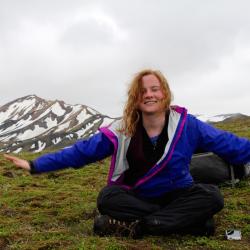
A week ago, during a session at the Arctic Circle conference, debates quickly turn to indigenous participation in media outlets, with almost forty-five minutes of white men from both sides of the pond speaking one after the other on the difficulties of inclusion and representation. Joan Kane, an Inupiaq American poet and experienced journalist, finally inserts a sharp knife into the conversation saying, “Hello, I’m sitting right here.”
For much of the Arctic Circle conference, the political, technological, and economic conversations went as such, gliding over indigenous rights as a bullet point (if these conversations even included such a bullet point) without adequately considering the indigenous voices present. Joan’s case was strengthened simply by the time it took to get to it.
Arctic dialogue
Hundreds of Arctic experts were drawn to Iceland at the end of last week by the Arctic Circle conference, a gathering proposed by President Ólafur Ragnar Grímsson in 2013 and housed at our very own Harpa. Participants spanned from bow-tied permafrost specialists to university students in ripped jeans, from the president of France, François Hollande, to a rumple-suited man taking selfie-stick photos all during Hollande’s keynote address. Conference discussions were impressively varied as well, touching on everything from the militarisation of the Arctic to the role of music in Arctic regions.
On top of the larger, more lecture-style plenary sessions, the conference included a series of breakout sessions, smaller and more discussion-based gatherings, and networking events – all intended to, according to the Arctic Circle organisation, “increase participation in Arctic dialogue and strengthen the international focus on the future of the Arctic.”
Joan, in particular, was invited to the conference as an artist and as a member of the ‘Polar Lab: A Shared North – An Arctic Identity’ panel, one comprised solely of indigenous participants. When I contacted her about her experience at the conference, Joan wrote that while hopeful about the conference’s future, her participation in the all-indigenous panel led her to “wonder to what extent indigenous issues (including climate change) are regarded as a sideshow to the other political and economic interests of the superpowers.”
The human dimension
In his keynote address, Icelandic Prime Minister Sigmundur Davíð Gunnlaugsson noted that human dimension needed to be of prime importance when considering climate change and its implications. He specifically cited the importance of working with indigenous peoples in these endeavours. Yet oftentimes, cohesive plans fail to emerge and ‘working with’ indigenous peoples, if it even happens, remains limited to certain disciplines.
Joan expressed this concern to me via e-mail: “Indigenous people are often regarded exclusively in terms of our anthropological or cultural value (if we are considered at all), which tends to further marginalize us within the context of climate change and resource exploitation.”
It was a true pleasure to walk through the halls of Harpa and inspect the indigenous artwork decorating it, to see advertisements for the Circum-Arctic art show, and to hear numerous indigenous musical performances during coffee breaks. Still, Joan’s words cast a sort of shadow on these displays. While beautiful, integral, and invaluable, these artistic representations cannot negate or ease the lack of indigenous representation in economic, technological, and political discussions.
The human dimension at the Arctic Circle conference
Now in its third year, the Arctic Circle conference is already a successful and crucial gathering, certainly a forum for discussion and certainly encouraging of international, cooperative decision-making. And if all goes well, it will continue to do so; already, conference dates have been set for the next three years. Many representatives at the conference even expressed distinct intentions of continuing these dialogues at the COP21 UN climate delegations in Paris in December. The Arctic Circle conference also evolves with every year.
In our interview with her before the conference, director of the Arctic Circle organisation, Sigríður Blöndal, specifically cited the ‘Health and Well-Being in the Arctic’ plenary session as the one for which she felt most excited. This larger plenary session had emerged out of a breakout session from the previous year, a nice showing of side issues gaining more traction with time. Furthermore, Sigríður viewed this session as integral in that it would stress something people often forget: there are actual people living in the Arctic.
Sitting right here
Many miles still remain in the trek towards true, honest, and holistic consideration of indigenous rights in discussions of Arctic affairs, yet hope for the future remains. If participants were confident in anything at the Arctic Circle conference, it was the insufficiency of current efforts to address climate change, as well as the need to do more in ensuring justice in the wake of these changes.
I ran into many unshakeable moments at the Arctic Circle conference. One of the more reverberating of these moments involved watching Yakutian ethno-singer Zarina Kopyrina perform during the conference’s last coffee break. Her ethereal sounds filled the halls of Harpa in a radical, hopelessly solid way, one that fell strangely onto the neat-napkin etiquette of the coffee hour.
Crowds gathered and dispersed as the gray Icelandic afternoon washed away. From one angle, Zarina was all silhouette and sound, dark feathered clothing against the gridded glass windows.
As I moved closer to take a photograph, Zarina’s face came into focus, vibrant and clear as day.
Just as the day was growing shorter.
Buy subscriptions, t-shirts and more from our shop right here!



















